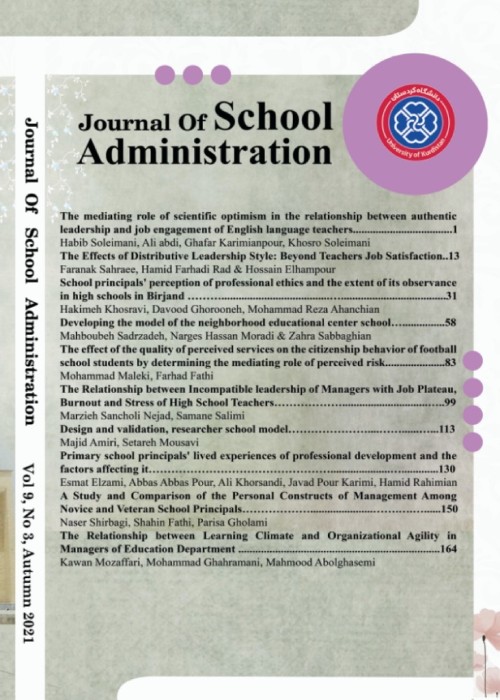Predicting Social Undermining based on Teachers'''' Perceptions of Different Types of Organizational Culture in Schools
The mission of education is to train an informed, efficient and committed force for the country; therefore, it is important to pay attention to human resources, the more capable and mentally healthy the human resources working in different organizational and administrative sectors, especially in educational organizations, the more progress and success that country will have in various fields. In most organizations, including educational organizations, various types of harmful administrative and cultural behaviors have been identified among employees, which due to the prevalence growing its negative consequences in the organization has received special attention. One of the undermining behaviors that can occur in organizations is social undermining, which is a deliberate and purposeful effort to destroy the others reputation and refer to their ability in establishing and maintaining positive interpersonal relationships. One of the variables that affect the quality of these behaviors is the dominant type of organizational culture in organizations. Organizational culture is a set of common meanings in an organization that, while creating common beliefs and values in an organization, determines the behavior and performance of employees. Paying attention to the quality and type of organizational culture as an underlying factor for the development of positive behaviors in the organization is essential. Therefore, according to what has been said, the main purpose of this study is to predict the level of social undermining among teachers based on their perception of the dominant type of organizational culture in their workplace. In this regard, the following hypotheses are proposed. What is the dominant type of organizational culture in the study area? What is the status of social undermining in the study area? What is the dominant dimension of social undermining in the study area? Is there a significant relationship between types of organizational culture (constructive, passive and aggressive) with social undermining? Which type of organizational culture is a significant predictor of social undermining?
This study was a descriptive- relational research. The statistical population included all school teachers in Shiraz schools selected by multi-stage cluster sampling method after selecting district one from the four districts of Shiraz schools, 10% of schools in the selected district, that 102 of them answered the questionnaires completely. Field data of types of organizational culture were surveyed using a researcher-made questionnaire of typology of organizational culture, which was introduced by a committee called (beyond change management, 2010). Field data related to social undermining were also collected using a researcher-made questionnaire of social undermining. In order to calculate the validity of each type of questionnaire, using correlation analysis method, the correlation between items with the total score of each item was calculated and to measure the reliability of each dimension of the questionnaire, Cronbach’s alpha method was used which had a very high reliability.
The findings indicate that according to teachers, the dominant organizational culture in the study area is passive or defensive culture. The reason for such a result can be attributed to the dominance of formal and informal procedures and processes in schools, the lack of independence of teachers in curriculum planning, and the lack of a suitable platform for creativity. In this regard, Yasini (2018) suggested the existence of innovative culture in schools is effective on people''s perception of school dynamics and individuals perceived performance of individuals. According to another finding of this study, from the teachers'' point of view, the average social undermining of schools in the study area was equal to the minimum level of adequacy (Q2). In other words, according to teachers, there is moderate social undermining in schools, the predominant dimension of which is related to direct social undermining. One of the reasons for achieving such a result can be primarily due to the dominance of passive organizational culture in the study area. In this way, Najafi & KHaleghkhah (2019) and Najafi & Khaleqkhah (2019) stated that there is a relationship between organizational culture dimensions, i.e. mission, compatibility and commitment to participation, with organizational justice. Another result of this study indicates that not only there is no positive and significant relationship between constructive organizational culture and social undermining, but also the type of constructive organizational culture does not predict social undermining. One of the possible reasons for achieving such a result is that, organizations in which participation, freedom of action, creativity and dynamism, commitment and trust are at a high level, exchange of information within and between networks takes place at a high level of trust. Also in the present study it was concluded that there is a positive and significant relationship between passive and aggressive organizational culture. Thus, passive organizational culture predicts 0.60 of social undermining and aggressive organizational culture predicts 0.43 of social undermining. Such a result indicates that the dominance of behaviours and the spirit of perfectionism, protest and continuous resistance of individuals with decisions made in the organization, the development of a negative atmosphere of competition to achieve a superior position are among the factors that organize the quality of performance and affect the occurrence or non-occurrence of undermining behaviours. Finally, it can be said that although the dominant type of organizational culture in the study area was passive and social undermining was at the average level, but the ability to significantly predict passive and aggressive organizational culture for social undermining, indicates the obvious impact of quality and type of organizational culture is based on the amount of social undermining.
- حق عضویت دریافتی صرف حمایت از نشریات عضو و نگهداری، تکمیل و توسعه مگیران میشود.
- پرداخت حق اشتراک و دانلود مقالات اجازه بازنشر آن در سایر رسانههای چاپی و دیجیتال را به کاربر نمیدهد.


